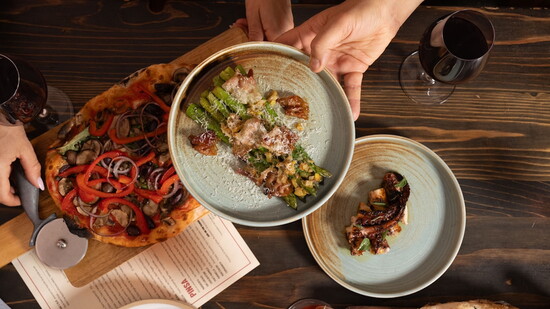Step inside Montesacro and you’re immediately transported—not just to another trendy restaurant, but to a corner of Rome that feels both timeless and alive. The air carries the warmth of fresh-baked pinsa, the Roman flatbread that’s lighter and crisper than pizza yet just as comforting. At the helm is Gianluca Legrottaglie, the man who introduced pinsa to the United States in 2015, forever changing how Americans think about Italian dining.
For Legrottaglie, food isn’t simply about taste; it’s about memory, family, and staying grounded in authenticity while embracing innovation. His culinary journey began long before opening his San Francisco location on Stevenson Street; it was rooted in the bustling markets of Rome, his mother’s home-cooked meals, and a deep respect for using simple ingredients to their fullest.
“I don’t like the word entrepreneur,” he says, “I prefer pioneer. I just want to present the cuisine I knew best—Roman cuisine—in a way that is true to my roots and open to what was happening here in the U.S.”
Moving to the United States in the late 1990s, in his early twenties, Italian food in America was often synonymous with heavy dishes like spaghetti and meatballs or chicken parmesan. While working at a Mediterranean restaurant in Nolita, New York, Legrottaglie discovered a new wave of chefs determined to showcase authentic regional Italian cooking. Inspired, he dove into local ingredients and realized American diners were ready for more than clichés.
Back home, Roman cuisine had always been about seasonality, affordability, and adaptability. His family’s meals were guided by what the mercato—the farmers market—had to offer that day. That philosophy of simplicity and resourcefulness became the backbone of Montesacro.
For Legrottaglie, pinsa embodies three elements: light, crispy, and easy to digest. Developed in Rome in 2001 by Corrado Di Marco, the unique flour blend behind pinsa creates a dough that’s different from traditional pizza.
“It’s not about reinventing the wheel,” he explains, “It’s about offering something rooted in tradition that feels fresh and relevant today.”
One of Montesacro’s standout creations is the Garbatella, a pinsa topped with caper mayonnaise, house-preserved yellowfin tuna, Calabrian chili, and pickled red onion. Inspired by his father’s love for tuna and onion pizza, it has earned national recognition and pairs perfectly with a crisp rosé.
Legrottaglie prioritizes substance, focusing on farmers, agriculture, and nutritional value rather than fleeting trends.
“Too many people forget that food’s first job is to nourish us,” he says, “Taste and pleasure matter, but so does quality. We work hard to innovate with simple, local ingredients while staying true to Roman traditions.”
That balance is also why unexpected dishes—like the octopus with olive oil and oregano—remain customer favorites. “It blows my mind how much people love it,” he admits, “It’s the simplest preparation, but Americans are always amazed by it.”
Legrottaglie says his Roman childhood shaped his philosophy: the late-summer ritual of making tomato sugo, the art of preserving vegetables, and his family’s reverence for extra virgin olive oil and wine.
“We were obsessed with food,” he says. “And we wasted nothing. Those lessons never leave you.”
Today, those lessons appear in every detail at Montesacro, from menu design to sourcing to the very atmosphere of the restaurant, which aims to transport diners into a Roman neighborhood without ever leaving the U.S.
Legrottaglie sees the future of Italian-American dining as a tug-of-war between nostalgia and spectacle. While many restaurants lean into Instagrammable design and “club-like” atmospheres, he insists Montesacro will always prioritize quality and cultural authenticity. “We want people to feel they’re in Rome,” he says.
And he’s not stopping there. The restaurant on Locust Street recently introduced an Italian breakfast every Saturday and Sunday morning. Here, mornings begin with espresso or cappuccino alongside cornetti, the softer, sweeter cousin of the French croissant, bomboloni, fruit tarts, and other house-made pastries. It’s another way Legrottaglie invites diners to start their day the Roman way.
Montesacro is a bridge between two cultures, one rooted in Roman tradition and the other hungry for authenticity.
